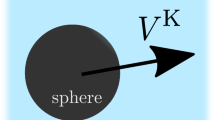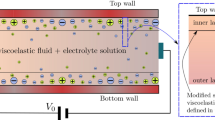Abstract
It is now well established that for fluid flow at the micro- and nano-scales the standard no-slip boundary condition of fluid mechanics at fluid–solid interfaces is not applicable and must be replaced by a boundary condition that allows some degree of tangential fluid slip. Although molecular dynamics studies support this notion, an experimental verification of a slip boundary condition remains lacking, primarily due to the difficulty of performing accurate experimental observations at small scales. In this article, three simple fluid problems are studied in detail, namely a fluid near a solid wall that is suddenly set in motion (Stokes’ first problem), the long-time behavior of a fluid near an oscillating solid wall (Stokes’ second problem), and the long-time behavior of a fluid between two parallel walls one of which is oscillating (oscillatory Couette flow). The no-slip boundary condition is replaced with the Navier boundary condition, which allows a certain degree of tangential fluid slip via a constant slip length. The aim is to obtain analytical expressions, which may be used in an experimental determination of the constant slip length for any fluid–solid combination.










Similar content being viewed by others
References
Abramowitz M, Stegun IA (1964) Handbook of mathematical functions. Dover, New York
Batchelor GK (2000) An introduction to fluid dynamics. Cambridge University Press, Cambridge
Bhushan B, Israelachvili JN, Landman U (1995) Nanotribology: friction, wear and lubrication at the atomic scale. Nature 374:607–616
Gad-el-Hak M (1999) The fluid mechanics of microdevices—the Freeman scholar lecture. J Fluids Eng 121:5–33
Granick S (1991) Motions and relaxations of confined liquids. Science 253:1374–1379
Granick S (1999) Soft matter in a tight spot. Phys Today 52:26–31
Granick S, Zhu Y, Lee H (2003) Slippery questions about complex fluids flowing past solids. Nat Mater 2:221–227
Karniadakis G, Beskok A, Aluru N (2005) Microflows and nanoflows fundamentals and simulation. Springer, New York
Lamb H (1932) Hydrodynamics. Cambridge University Press, Cambridge
Matthews MT, Hill JM (2007a) Nano boundary layer equation with nonlinear Navier boundary condition. J Math Anal Appl 333:381–400
Matthews MT, Hill JM (2007b) Micro/nano thermal boundary layer equations with slip-creep-jump boundary conditions. IMA J Appl Math 72:894–911
Matthews MT, Hill JM (2008a) Nanofluidics and the Navier boundary condition. Int J Nanotechnol 5:218–242
Matthews MT, Hill JM (2008b) A note on the boundary layer equations with linear slip boundary condition. Appl Math Lett (accepted for publication)
Maxwell JC (1879) On stresses in rarefied gases arising from inequalities of temperature. Philos Trans R Soc Lond 170:231–256
Navier CLMH (1823) Mémoire sur les lois du mouvement des fluides. Mémoires Acad R Sci Inst France 6:389–440
Nguyen NT, Wereley ST (2006) Fundamentals and applications of microfluidics. Artech House, Norwood
Sen M, Wajerski D, Gad-el-Hak M (1996) A novel pump for MEMS applications. J Fluids Eng 118:624–627
Sharipov F, Kalempa D (2007) Gas flow near a plate oscillating longitudinally with an arbitrary frequency. Phys Fluids 19:017110
Sharipov F, Kalempa D (2008) Oscillatory Couette flow at arbitrary oscillation frequency over the whole range of the Knudsen number. Microfluidics Nanofluidics 4:363–374
Slattery JC (1999) Advanced transport phenomena. Cambridge University Press, Cambridge
Veijola T, Turowski M (2001) Compact damping models for laterally moving microscructures with gas-rarefaction effects. J Microelectromech Syst 10:263–273
Yakhot V, Colosqui C (2007) Stokes’ second flow problem in a high-frequency limit: application to nanomechanical resonators. J Fluid Mech 586:249–258
Acknowledgments
This work is funded by the Discovery Project scheme of the Australian Research Council, and the authors gratefully acknowledge this support. JMH is grateful to the Australian Research Council for provision of an Australian Professorial Fellowship.
Author information
Authors and Affiliations
Corresponding author
Rights and permissions
About this article
Cite this article
Matthews, M.T., Hill, J.M. On three simple experiments to determine slip lengths. Microfluid Nanofluid 6, 611–619 (2009). https://doi.org/10.1007/s10404-008-0338-9
Received:
Accepted:
Published:
Issue Date:
DOI: https://doi.org/10.1007/s10404-008-0338-9




